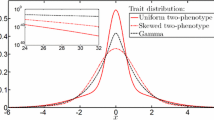Abstract
We study how the speed of spread for an integrodifference equation depends on the dispersal pattern of individuals. When the dispersal kernel has finite variance, the central limit theorem states that convolutions of the kernel with itself will approach a suitably chosen Gaussian distribution. Despite this fact, the speed of spread cannot be obtained from the Gaussian approximation. We give several examples and explanations for this fact. We then use the kurtosis of the kernel to derive an improved approximation that shows a very good fit to all the kernels tested. We apply the theory to one well-studied data set of dispersal of Drosophila pseudoobscura and to two one-parameter families of theoretical dispersal kernels. In particular, we find kernels that, despite having compact support, have a faster speed of spread than the Gaussian kernel.
Similar content being viewed by others
References
Anderson, K., Nisbet, R., Diehl, S., Cooper, S., 2005. Scaling population responses to spatial environmental variability in advection dominated systems. Ecol. Lett. 8, 933–943.
Aronson, D., Weinberger, H.F., 1975. Nonlinear diffusion in population genetics, combustion, and nerve pulse propagation. In: Goldstein, J. (Ed.), Partial Differential Equations and Related Topics, Lecture Notes in Mathematics, vol. 446. Springer-Verlag, pp. 5–49.
Brockmann, D., Hufnagel, L., Geisel, T., 2006. The scaling laws of human travel. Nature 439, 462–465.
Byers, J., Pringle, J., 2006. Going against the flow: Retention, range limits and invasions in advective environments. Mar. Ecol. Prog. Ser. 313, 27–41.
Clark, J., Silman, M., Kern, R., Macklin, E., HilleRisLambers, J., 1999. Seed dispersal near and far: Patterns across temperate and tropical forests. Ecology 80(5), 1475–1494.
Dembo, A., Zeitouni, O., 1998. Large Deviations Techniques and Applications. Applications of Mathematics. Springer, New York.
Dobzhansky, T., Wright, S., 1943. Genetics of natural populations. X. Dispersion rates in Drosophila pseudoobscura. Genetics 28, 304–340.
Fisher, R., 1937. The advance of advantageous genes. Ann. Eugen. 7, 355–369.
Hastings, A., Cuddington, K., Davies, K., Dugaw, C., Elmendorf, A., Freestone, A., Harrison, S., Holland, M., Lambrinos, J., Malvadkar, U., Melbourne, B., Moore, K., Taylor, C., Thomson, D., 2005. The spatial spread of invasions: New developments in theory and evidence. Ecol. Lett. 8, 91–101.
Kot, M., Lewis, M., van den Driessche, P., 1996. Dispersal data and the spread of invading organisms. Ecology 77, 2027–2024.
Lutscher, F., Pachepsky, E., Lewis, M., 2005. The effect of dispersal patterns on stream populations. SIAM Appl. Math. 65(4), 1305–1327.
Medlock, J., Kot, M., 2003. Spreading diseases: Integro-differential equations new and old. Math. Biosci. 184, 201–222.
Metzler, R., Klafter, J., 2000. The random walk's guide to anomalous diffusion: A fractional dynamics approach. Phys. Rep. 339, 1–77.
Murdoch, W., Briggs, C., Nisbet, R., 2003. Consumer-Resource Dynamics. Monographs in Population Biology. Princeton University Press.
Neubert, M.G., Kot, M., Lewis, M.A., 1995. Dispersal and pattern formation in a discrete-time predator-prey model. Theor. Popul. Biol. 48(1), 7–43.
Nisbet, R., Lutscher, F., Pachepsky, E., in preparation. Population persistence in the face of advection.
Pachepsky, E., Lutscher, F., Nisbet, R., Lewis, M.A., 2005. Persistence, spread and the drift paradox. Theor. Popul. Biol. 67, 61–73.
Petrov, V., 1975. Sums of Independent Random Variables. Springer, Berlin.
Pielaat, A., Lewis, M., Lele, S., de Camino-Beck, T., 2005. Sequential sampling design for catching the tail of dispersal kernels. Ecol. Model. 190, 205–220.
Siegel, D., Kinlan, B., Gaylord, B., Gaines, S., 2003. Lagrangian descriptions of marine larval dispersion. Mar. Ecol. Prog. Ser. 260, 83–96.
Taylor, R., 1978. The relationship between density and distance of dispersing insects. Ecol. Entomol. 3, 63–70.
Tufto, J., Ringsby, T.-H., Dhondt, A., Adriaensen, F., Matthysen, E., 2005. A parametric model for estimation of dispersal patterns applied to five passerine spatially structured populations. Am. Nat. 165, E13–E26.
van den Bosch, F., Hengeveld, R., Metz, J., 1992. Analysing the velocity of animal range expansion. J. Biogeography 19, 135–150.
Weinberger, H.F., 1982. Long-time behavior of a class of biological models. SIAM J. Math. Anal. 13, 353–396.
Author information
Authors and Affiliations
Corresponding author
Rights and permissions
About this article
Cite this article
Lutscher, F. A Short Note on Short Dispersal Events. Bull. Math. Biol. 69, 1615–1630 (2007). https://doi.org/10.1007/s11538-006-9182-9
Received:
Accepted:
Published:
Issue Date:
DOI: https://doi.org/10.1007/s11538-006-9182-9



